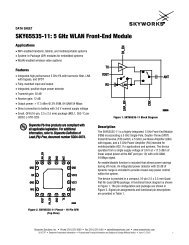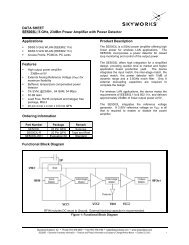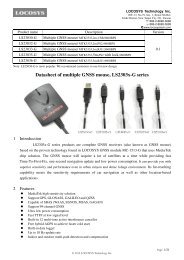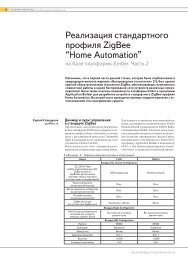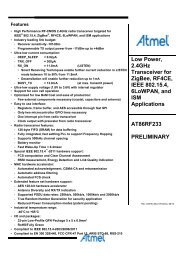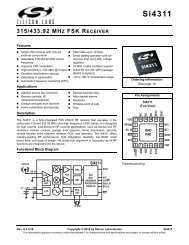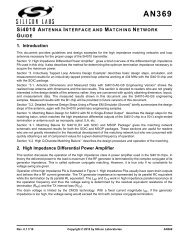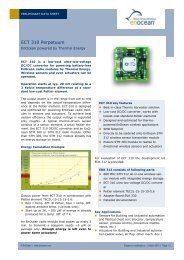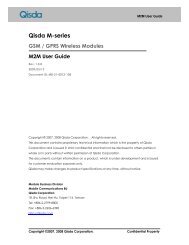Bluetooth Commands - wless.ru
Bluetooth Commands - wless.ru
Bluetooth Commands - wless.ru
You also want an ePaper? Increase the reach of your titles
YUMPU automatically turns print PDFs into web optimized ePapers that Google loves.
Chapter 2 – AT <strong>Commands</strong><br />
Park and Sniff (Connected Slave) <strong>Commands</strong><br />
Supported in Point-to-Point mode only!<br />
Low Power Modes Using Sniff<br />
<strong>Bluetooth</strong> connections are master/slave in nature. A master sends packets and a slave has to<br />
acknowledge the packet in the next time slot. Time slots in <strong>Bluetooth</strong> are 625 microseconds wide. This<br />
implies that a master will always know when packets will be sent and received, which further means it is<br />
able to optimize power usage by switching on power-hungry circuitry only when needed.<br />
A slave, on the other hand, does NOT have prior knowledge of when a packet will be received and has to<br />
assume that a packet will be received from a master on every receive slot. This means that it has to leave<br />
its receiving circuitry on for most of the receive slot duration. The result of this is high power consumption<br />
because a slave with no data transmission still consumes around 5mA.<br />
This problem was identified very early in the evolution of <strong>Bluetooth</strong> (especially since headsets spend all<br />
their time as a slave in a <strong>Bluetooth</strong> connection) and it was solved by having a mode called Sniff, with<br />
appropriate lower layer negotiating protocol.<br />
Sniff mode during connection is basically an agreement between the slave and its master in which data<br />
packets will only be exchanged for N time slots every M slots. The slave can then assume that it will never<br />
be contacted during N-M slots, and so can switch its power-hungry circuitry off. The specification goes<br />
further by also specifying a third parameter called ‘timeout’ (T) which specifies ‘extra’ time slots that the<br />
slave will agree to listen for after receiving a valid data packet. Put another way, if a data packet is received<br />
by the slave, then it knows that it MUST carry on listening for at least T more slots. If, within that T slot time<br />
period, another data packet is received, then the timer is restarted. This mechanism ensures low power<br />
consumption when there is no data transfer – at the expense of latency. When there is a lot of data to be<br />
transferred, it acts as if sniff mode were not enabled.<br />
It is stated above that during sniff mode, a slave listens for N slots every M slots. The <strong>Bluetooth</strong><br />
specification states that a master can have up to 7 slaves attached to it with all slaves having requested<br />
varying sniff parameters. It may, therefore, be impossible to guarantee that each slave gets the M<br />
parameter it requested. In light of this, the protocol for enabling sniff mode specifies that a requesting peer<br />
specify the M parameter as a minimum and maximum value. This will allow the master to interleave the<br />
sniff modes for all slaves attached.<br />
SNIFF Enable Sniff<br />
Manually enables sniff mode for Slave devices connected in time slots.<br />
Format:<br />
ATSNIFF,,,,<br />
Parameters:<br />
• Max Interval: Integer Value<br />
Time [ms] = Max Interval * 0.625ms<br />
• Min Interval: Integer Value<br />
Time [ms] = Min Interval * 0.625ms<br />
• Attempt: Integer Value<br />
Time [ms] = Attempt * 0.625ms<br />
• Timeout: Integer Value<br />
Time [ms] = Timeout * 0.625ms<br />
EXAMPLE:<br />
TYPE: ATSNIFF,1600,160,10,160<br />
REPLY: OK<br />
OR<br />
NO CARRIER<br />
Notes:<br />
• Manually enabling sniff results in an always connected slave using only 2mA average<br />
current when no data is sent. It takes about 7 seconds before the current drops after the<br />
connection is established. Parameters are lost after the connection is dropped.<br />
• The device will exit sniff mode once the connection is terminated. ATSNIFF must be<br />
executed again upon establishing a new connection in order to start sniff mode again.<br />
Multi-Tech Systems, Inc. SocketWireless <strong>Bluetooth</strong> AT <strong>Commands</strong> (S000360G) 42




